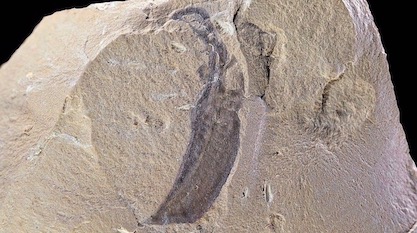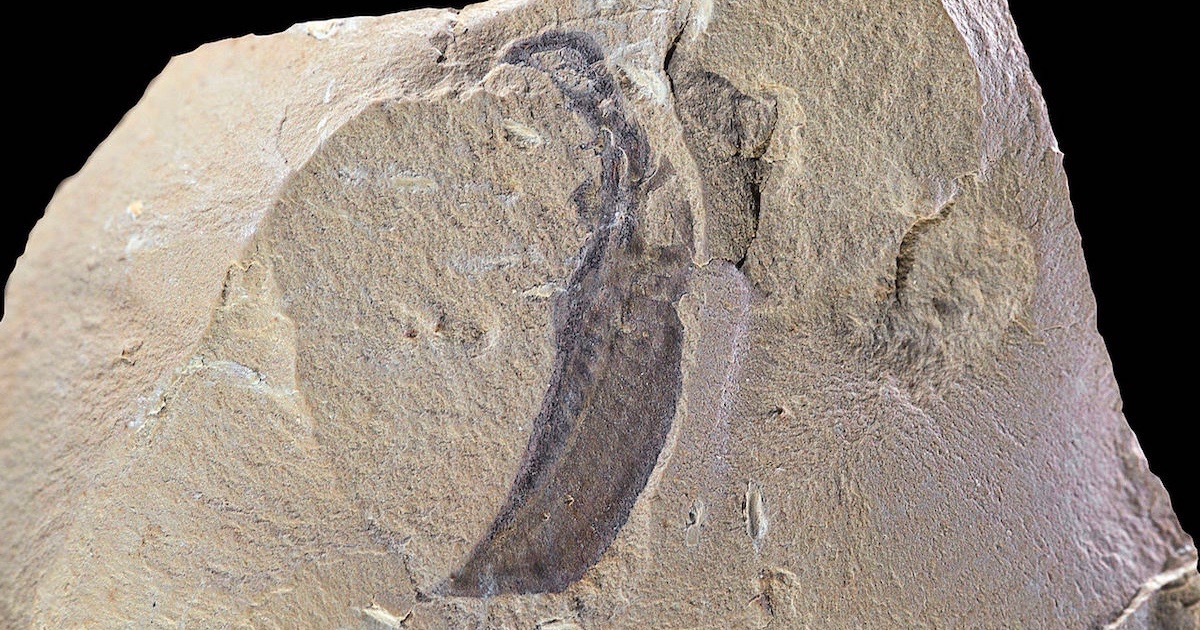 Evolution
Evolution
To Solve a (Cambrian) Problem: Declare It Solved!


You can solve any problem the easy way: just say it has been solved. For best effect, add fanfare and flourish. Lead in with tension and drama. Toss in colorful displays of irrelevant evidence. Above all, sound confident, look excited, and imply you have the opinions of the best experts on your side. Maybe nobody will notice.
Graham Lawton gives a good performance along these lines in New Scientist, where he reviews a dashing new exhibit of Cambrian fossils at the Oxford University Museum of Natural History:
It came to be known as Darwin’s dilemma: why did animal life appear abruptly in the fossil record 542 million years ago, having left no trace in earlier rocks? In his book On the Origin of Species, Charles Darwin admitted: “I can give no satisfactory answer.” The origin of animals was duly elevated to one of the great mysteries of evolution.
In the past few decades, the mystery has been solved. Animals didn’t appear in the blink of an eye during the “Cambrian explosion”, but evolved gradually in the Precambrian, the so-called “long fuse” of the Cambrian explosion. Even so, the origin of animal life remains one of palaeontology’s most interesting and contentious questions, and the fossils telling the story are among the world’s most famous and fascinating. [Emphasis added.]
Yes, it is very fascinating to be able to tell a whopper like this without blushing.
The museum exhibit is, by all appearances, fascinating: it contains some of the finest Cambrian fossils from the Chengjiang fossil bed, seen for the first time outside China. But does the exhibit show evolution? That is Lawton’s challenge.
“Science is truth,” Finagle’s Creed declares: “Don’t be misled by facts.” That Murphyism is amusing, but it becomes wise advice if you change it to, “Don’t be misled by irrelevant facts.”
Irrelevant Facts
Graham Lawton is on the witness stand to testify whether the fossils in the Oxford exhibit “First Life” demonstrate that Darwin’s dilemma has been “solved.”
- The museum is beautiful. Objection: Irrelevant.
- The Chengjiang fossils are exceptionally well preserved. Objection: Irrelevant.
- The Chengjiang fossils have surpassed the Burgess Shale in scientific importance. Objection: Irrelevant.
- The Chengjiang fossils are 10 million years older than the Burgess Shale. Objection: Irrelevant.
- “Many of the Chengjiang fossils have never been seen outside China before.” Objection: Irrelevant.
- “Burgess Shale fossils are also on show, plus some from a lesser-known but equally important site in Greenland called Sirius Passet.” Objection: Irrelevant.
- “[T]here are casts of Ediacaran fossils, representatives of an ecosystem of large animals that lived long before the Cambrian.” Objection: Irrelevant. The Ediacarans are not ancestors of the Cambrian animals. Calling them animals is misleading.
On it goes. The museum includes exhibits on molecular clocks, Lawton says, but that evidence contradicts the age of these fossil, and assumes evolution (circular reasoning). The museum includes exhibits on “developmental genetics” (presumably evo-devo) which also assumes evolution, and does not explain where the information for new hierarchical body plans and systems came from.
In the end, Lawton unwittingly gets excited about the abrupt appearance of complex organs:
The extraordinary detail of preservation seen in some of the fossils is a thing of wonder. These animals are more than half a billion years old yet their eyes, gills, legs, internal organs and even muscles are intact. For a glimpse of life right at the start of the age of animals, you can’t ask for anything better than this.
Eyes. Gills. Legs. Organs. Muscles. Think of it! None of these are present in the Ediacaran fauna. Can anyone looking at these things with their “extraordinary detail” really believe that they popped into existence in a geological instant by mindless, aimless, natural processes? Stephen Meyer would ask, Where did the information come from to design such things?
Add Some Magic Sparks
Remember when science got rid of the “divine spark” in life? That was assumed to represent progress, because scientists no longer needed “magical” causes to explain things. Now, evolutionists use natural sparks to do it. Evolutionists at Ohio University, not content with one explosion, add a second one:
The early evolution of animal life on Earth is a complex and fascinating subject. The Cambrian Explosion (between about 540 to 510 million years ago) produced a stunning array of body plans, but very few separate species of each, notes [Alycia] Stigall. But nearly 40 million years later, during the Ordovician Period, this situation changed, with a rapid radiation of species and genera during the Great Ordovician Biodiversification Event.
So what led to this rapid radiation? Read about “Lighting the Spark of Diversification” in the article. It was a magic combination of cooling, nutrient availability, and oxygen, we learn. Given the availability of materials, those simple animals had no choice but to diversify. The environment made them do it.
These physical changes were necessary building blocks, but on their own were not enough to light the spark of diversification.
The missing ingredient was a method to alternately connect and isolate populations of species through cycles of vicariance and dispersal. That spark finally occurs in the Darriwilian Stage when ice caps form over the south pole of the Ordovician Earth. The waxing and waning of these ice sheets caused sea level to rise and fall (similar to the Pleistocene), which provided the alternate connection and disconnection needed to facilitate rapid diversity accumulation.
The right combination caused a “diversification pulse,” they say. If this is not magic, it should be testable. Build a large tank with controls on temperature and water depth. Put in some pre-Ordovician animals. Monitor what happens.
Darwinism resists falsification because the parameters are all adjustable. “Early species developed much faster than previously thought,” they say. By simply declaring it to be so, the rapid diversification confirms Darwinism rather than falsifying it. Just move the dial labeled “speciation rate” from slow to fast. Problem solved! The dial goes all the way from static to explosively fast. Darwin can’t lose.
Materials Make Their Own Buildings
Another way evolutionists can solve their problems by declaring them solved is by answering the wrong question. For instance, a paper in PNAS spends all its time and energy explaining how the ingredients for biomineralization arrived in time for the Cambrian animals to build things out of them. In their paper “Biomineralization by particle attachment in early animals,” Andrew Knoll and six colleagues argue that the arrival of calcium carbonate explains skeletons.
The mechanisms by which organisms form mineralized skeletons have been a major research focus for the last 50 y and remain so today. Among the most surprising discoveries is the recent observation that different animals use the same mechanisms, and precisely the same amorphous precursors, to form biomineralized structures as diverse as coral skeletons, molluscan shells, and sea urchin spines. In living animals, skeletal biomineralization from amorphous precursors correlates with a distinctive nanoparticulate texture that can be preserved in fossils, enabling us to probe mechanisms of skeletal formation in early animals. We document nanoparticulate texture in some of the oldest known carbonate skeletons, which strongly suggests that skeletons formed from amorphous precursors throughout the recorded history of animals.
With apologies for the pun, this is a shell game. The availability of calcium carbonate does not explain shells, just as the availability of bricks cannot explain houses. Surely the most interesting question is how animals use the materials to build the intricate shapes and mineralized body plans. Where is the blueprint for a trilobite, a mollusk, or a brachiopod? Accounting for material does not explain the elegant conch shell with its golden ratio geometry.
These authors think they have contributed to understanding evolution, when all they did was answer the wrong question. Materials are necessary but not sufficient for biomineralized body plans, just as textured cloth is necessary but not sufficient for an evening gown; a dressmaker must take the material and fashion a work of art out of it.
Even so, the authors had to sprinkle in their magic ingredient of “convergence” to salvage Darwinism. “The convergent evolution of biomineral CPA [“crystallization by particle attachment”] may have been dictated by the same thermodynamics and kinetics as we observe today,” they say. But laws of physics do not dictate body plans! This appeal to laws of nature brings to mind a quip you’ll see on the Internet: “If the art of ship-building were in the wood, ships would exist by nature.” In this case, if the art of shells were in sea water with dissolved calcium carbonate in it, conch shells and trilobite exoskeletons would emerge from the sea water itself acted on by the laws of physics. That should be testable in a lab. Will they try it out by experiment, instead of declaring it to be true?
Photo: Haikouella lanceolata, from the Chengjiang fossil bed, by Didier Descouens [CC BY-SA 4.0], via Wikimedia Commons.
